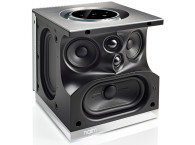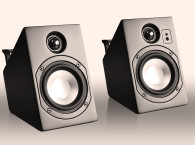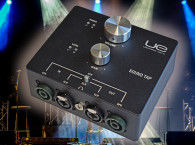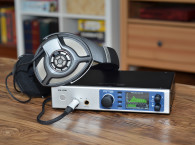
Some of us love ribbon and dynamic microphones and what they do for the sounds they pick up. Unfortunately, some of our preamplifiers don’t share our love for them—ribbons and dynamics tend to have pretty low output, and microphone preamplifiers (whether separate or built in to a mixer, PA, or digital interface) don’t always have a noise floor, gain, and dynamic range that are suitable. Users often have to turn up the gain to the point where noise intrudes or they run out of gain completely, with the gain knob all the way up but the mic volume still too low.
Realizing a need, several manufacturers have created pre-preamps, giving some gain boost to bring the microphone output level up to the point where the noise floor and gain limitations of the mixer recede into the background. Typically, these pre-preamps have 20 to 30 dB of gain and are powered from the mixer mic input’s phantom power (usually 48 V), with isolation of the phantom power from the preamp input. Popular versions include the Cloud Microphones CL-1 and the Triton Fethead.
The Simply Sound Company, a Utah-based startup, has entered the fray with its SS-1 preamp (see Photo 1). The SS-1 is a single channel preamp, meant to boost the signal of a low output microphone to levels compatible with normal mic inputs. It’s housed in a rugged extruded aluminum case, with XLR connections on each end. The internal circuitry is transformerless and all-discrete, comprising a differential FET cascade using four LSK170 low noise N-channel FETs. It appears to be running open loop. Construction is on a two-sided PCB with through-hole components, and a neat and uncrowded layout (see Photo 2).

Despite the high-quality parts and good construction, the SS-1 sells for significantly less than competitive products —less than $80 at the time of this writing.
Performance Testing
As usual, I conducted the measurements using an Audio Precision APx515, with the APx1701 transducer interface providing the phantom power. Basic measurements showed a 31.2 dB and a 31.4 dB gain for the two units, which is very good matching for an open-loop circuit. This is higher than the SS-1 gain specification of 25 dB, but the AP analyzer has a higher input impedance than the 3 kΩ used for the spec. Output impedance of the SS-1 measured 2875 Ω, so the voltage divider formed by the output and load impedances accounts for the 6 dB difference from spec. The high source impedance suggests that the FET cascodes are not buffered and that there’s no feedback loop, the source impedance then being dominated by the FET drain load resistors.

The frequency response is shown in Figure 1. There’s a slight rolloff in the top octave (about -0.7 dB), which might be barely audible to young fresh ears, but only if the microphone has an extended high end. It occurred to me that the rolloff could be a function of the input capacitance, so I re-measured the frequency response at different source impedances. Changing the source impedance had no effect on the frequency response, so the rolloff appears to be intrinsic to the circuit.


Figure 2 shows THD+noise vs. input level at 1 kHz, taken using 90 kHz and 22.4 kHz bandwidths. The measurement is noise-dominated up to about 7 mV (for the 22.4 kHz measurement bandwidth), where it reaches a minimum of 0.012%. As the level increases, distortion rises, but is still low (0.05%) at 30 mV in. This corresponds to about a 1 V output, which is much more than would be encountered in real-world use. The variation of THD with frequency at 5 mV in is shown in Figure 3. It’s nearly flat across the audio band, characteristic of so-called zero feedback circuits.
Distortion spectra at 1 mV and 40 mV in are shown in Figure 4. For clarity, I shifted the fundamental frequency by 200 Hz between the two measurements. The latter input voltage disproportionately increases second and third harmonics, although they still remain relatively low at under -70 dB (0.03%). Intermodulation distortion (IMD) was similarly low: at 200 mV out (5.4 mV in), 19/20 kHz IMD was dominated by the 1 kHz first order product at -91 dB (0.003%), shown in Figure 5. This is excellent performance for an open-loop circuit.


The SS-1’s spectrum of a 200 mV output multi-tone torture test (40 tones, each spaced half octave apart) is shown in Figure 6. Distortion is indicated by the presence of tones or hash between the test signal tones. In this case, all distortion products were at -105 dB or lower, with very little discernible hash — a good result. Signal-to-noise ratio (SNR) was 80 dB for a 5 mV input, measured over a 20 kHz bandwidth, A-weighted. Figure 7 shows the noise spectrum of the SS-1 compared to the noise of the microphone preamps built into the Scarlett 2i2 when set for equal levels. The penalty for the extra gain of the SS-1 is a bit more noise (2 dB or so), which may or may not be significant, depending on the microphone used and the nature and level of the sound sources. I’ll give an example in the next section.
One advantage of the construction and components chosen is a lack of microphonics. Monitoring the output while tapping vigorously on the SS-1, I saw no signal resulting from the mechanical excitation. In actual use, the preamps also showed no tendency toward noise or feedback, even when placed close to the PA monitors.

To determine noise rejection, I fed a common-mode signal (i.e., the same polarity and amplitude to pins 2 and 3 of the input XLR connector) of 2 mV to the SS-1. Compared to the same signal applied in (normal) differential mode, the output of the common mode signal was attenuated by 42 dB. I obtained an almost identical performance from the second unit. Here’s where a transformerless open-loop design has a disadvantage compared to transformers or more sophisticated feedback-based designs, which can give 90 dB or more of common-mode rejection. I should note, though, that the 42 dB common-mode rejection held up from 20 Hz to 20 kHz. In practice, I did not encounter hum pickup or other sorts of common-mode noise pickup issues, suggesting that the grounding and shielding of this design is well-executed.

Wrap-Up
I used the SS-1s for some field recording with my ribbon microphones, interposed between the mics and a Focusrite Scarlett 2i2 interface, which provided the phantom power. My mics have a sensitivity of 2.6 mV/Pa, so often need a boost unless used for a very loud sound source or very close up. The SS-1s came in particularly handy for an acoustic guitar recording where the mics had to be backed off because of a rickety (and resonant) stage area. The boost from the SS-1s let me set the input level controls of the 2i2 to near midpoint at a good recording level (occasional peaks at -2 to 3 dBFS), without issues of noise or distortion.
Regarding the noise floor, for the 2.6 mV/Pa sensitivity of my mics, the equivalent noise floor (20 kHz bandwidth, A-weighted) of the SS-1 is 18.6 dB SPL which, although not negligible, is significantly quieter than any room I record in, and only about a decibel higher than the self-noise of my mics. In practice, I could not hear the noise of the preamps over the recorded ambient noise.
The SS-1’s solid construction will survive a lot of the banging around that is normal for gigs and location recording, and in my field use, the two SS-1 units performed silently and flawlessly. As the measurements suggested, there’s no “sound” or significant coloration other than the small treble rolloff. The high overload margins will accommodate a range of mike sensitivities and the dynamics of live sound. A true state-of-the-art preamp could exceed the SS-1’s performance, but at a much greater cost and questionable audible improvement. For a small studio or touring musician, the SS-1 is an inexpensive and useful accessory. ax
SS-1 Microphone Preamp
The Simply Sound Co.
PO Box 17109
Salt Lake City, UT 84117
800-556-4006
Price: $74.99
Resources
Focusrite Scarlett digital interface - https://us.focusrite.com/scarlett-range.
The Simply Sound Company - simplysound.co.
This article was originally published in audioXpress, December 2017







